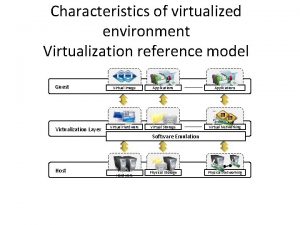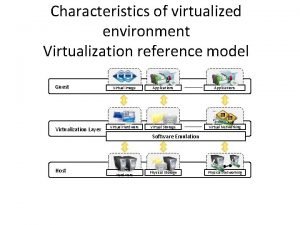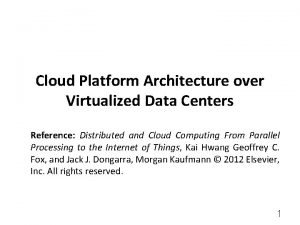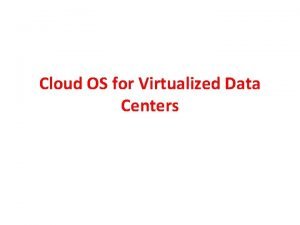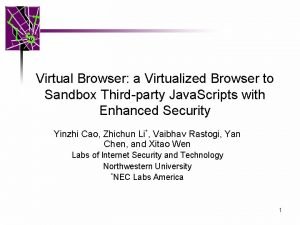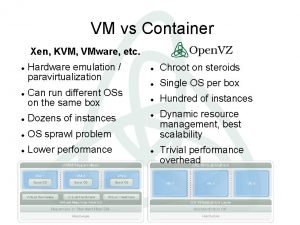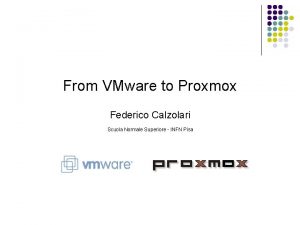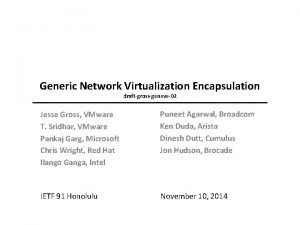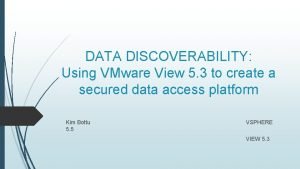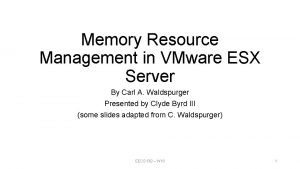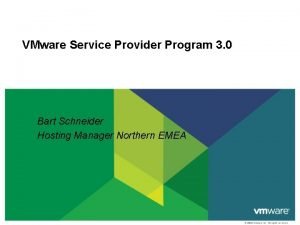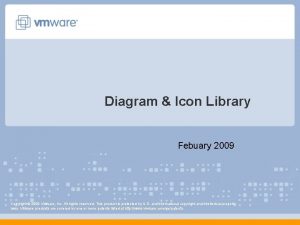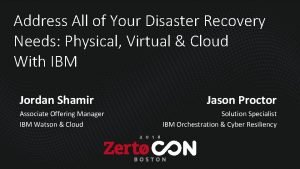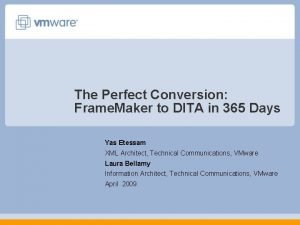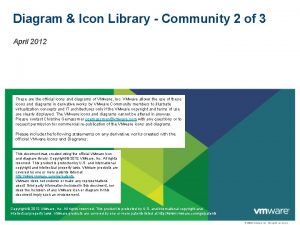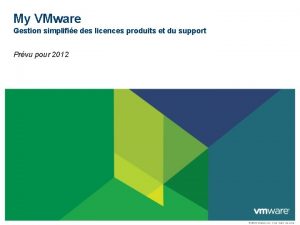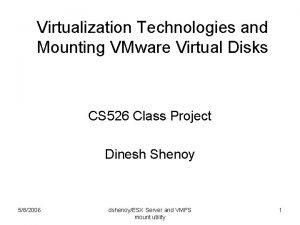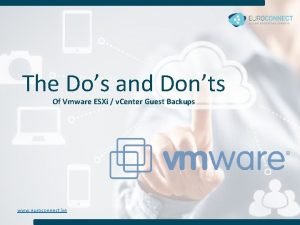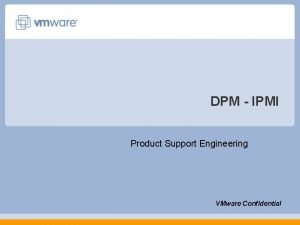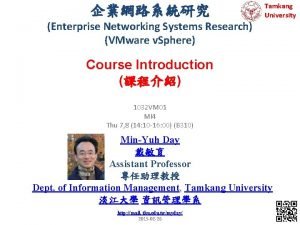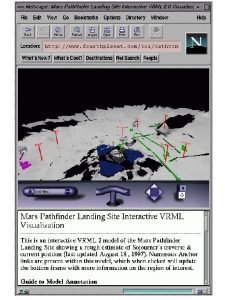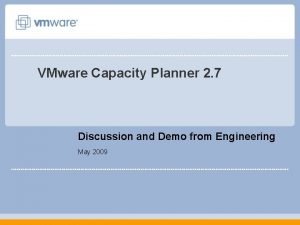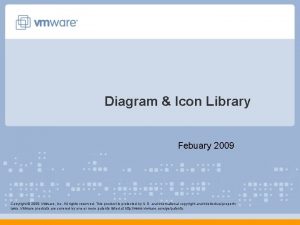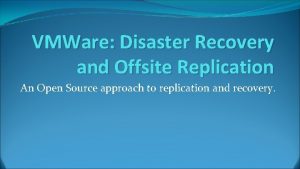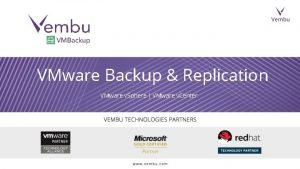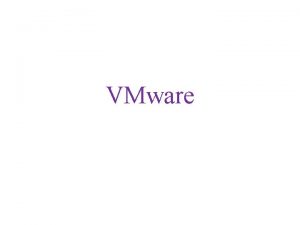VMware Virtualized Networking Anthony Critelli 10242017 RIT Next




































- Slides: 36

VMware Virtualized Networking Anthony Critelli 10/24/2017 RIT Next. Hop

Agenda/Goals Discuss some of the networking challenges in a modern virtual environment Introduce generalized solutions Provide an overview of what VMware is doing Hopefully get everyone interested

Challenges What problems are we actually trying to solve?

How did we configure networks 20 years ago?

The olden days

How do we configure networks now?

We’ve come a long way

Why is this a problem? We can’t adjust to change easily The network can be opaque Adding a new logical segment can take time and coordination across multiple teams No “single pane of glass” or easy way for others to see how things are set up This approach is error-prone switchport trunk allowed vlan 10 Whoops, I forgot the “add” keyword Example: several developers want identical, multi-tiered application networks to perform testing and development on

Current Topology

How do I fulfill the developer’s request? 1. Ask the network team to add a VLAN 1. Must be added on each switch in network (never use VTP) 2. Must be added to uplinks 2. Add a port group 3. Add VMs to the correct port group 4. Maybe re-architect the network if hosts are on different subnets This isn’t hard, but it’s also not dynamic and can result in errors

How do I want to fulfill the developer’s request?

What technologies do we use? This sounds cool, but how do we actually do it?

Overlay Networking Create a logical network between the hosts We don’t care about how the packets get between the hosts Well…Joel Spolsky’s Law of Leaky Abstractions still applies Hosts could be on different networks, in different datacenters, etc. As long as they can talk, their virtual switches can talk We need some kind of header/protocol to handle this

Overlays This can sometimes be hard to wrap our head around Simple example: VPN PC 1 and PC 2 have no idea of the routers/network in between They just think they’re on one logical network segment: 10. 1. 1. 0/24

VXLAN Virtual e. Xtensible LAN RFC 7348 Really, it’s pretty simple: Create a virtual network with an ID (VXLAN Network Identifier/VNI) Add a header with that ID Send the encapsulated traffic between hosts (VXLAN Tunnel Endpoint/VTEP)

What does the packet look like? Source: VMware NSX for v. Sphere (NSX) Network Virtualization Design Guide

From old to new

Lots of considerations New headers = larger packets MTU concerns How do we handle ARP/broadcast/multicast traffic Different implementations do different things We could use a logically central controller Intercept ARP requests and provide responses We could use multicast: send traffic out to all VTEPs with guests in the associated logical network Many vendors are doing different things that incorporate VXLAN in some way

VMware What are they doing?

NSX is VMware‘s network virtualization solution Tons of different components More on that in a second Integration with v. Center NSX-T and NSX-V is for use with v. Center, and is the classical way of doing NSX-T is very new (announced officially at VMworld 2017) and is multi-cloud Control your network for AWS, on-prem, etc. all from one central management plane This discussion will focus on NSX-V

Features – there’s a lot of them Distributed Firewall Logical switch Microsegmentation VXLAN and logical network segmentation Distributed Logical Router A logical router that can span across all of your VMware hosts Solves traffic hairpinning – routed traffic between two VMs on the same host never leaves the host Traditional routing protocols to peer your VMware environment with the outside world NSX Edge Load balancing, VPN services, NAT, DHCP, etc.

Distributed Firewall (DFW) A bit of a gateway drug into NSX Single place to control firewall rules that take effect at the hypervisor level before the virtual NIC Can cut out the host firewall Can dynamically control VM-to-VM communication Even on the same network! No need to draw security boundaries on subnet boundaries Microsegmentation Automatically place VMs into groups based on criteria and apply policy Very granular policies about what types of communication are allowed Third-party integrations

DFW Source: VMware NSX for v. Sphere (NSX) Network Virtualization Design Guide

Logical Switch Quickly and easily deploy a layer 2 network across our VMware environment No need to modify underlying VLANs or physical network VXLAN-based overlay Using logical switches and routers, we can deploy a fully isolated multi-subnet network across our VMware environment without ever touching a switch or physical router And all of this has an API, so we can do it programmatically and through our automation tools

Distributed Logical Router Solves traffic hairpinning Consider how inter-VM traffic for different subnets on the same host routes Traffic must go out to an external router and come back into the same host Wasteful – why does traffic on the same physical host need to leave the host? Distributed router places a data plane on each host, so this traffic is routed logically Outside connectivity Connect via OSPF or BGP Traffic Hairpin

Architecture Source: VMware NSX for v. Sphere (NSX) Network Virtualization Design Guide

Architecture Like any network architecture, we have: Management plane Control plane Data plane

Management Plane NSX manager Deployed as an OVA Tightly coupled with v. Center server Bind NSX manager to v. Center server after initial setup Most actual network configuration is done in v. Center Acts as the API endpoint and communicates with changes made in v. Center

Control Plane NSX controllers Deployed as VMs during NSX setup NSX handles the actual deployment for you Just need to specify an IP pool for the controllers to get IPs from Deployed in cluster of 3 Recommend creating an affinity rule to prevent them from being on the same host Logical router control VM When using a DLR, a router VM is also deployed You can connect and execute commands to view the routing table, etc.

Data Plane Hypervisor kernel modules VIBs These handle forwarding of traffic, firewall allow/deny, etc. Pushed down to hosts through v. Center NSX Edge appliances Certain data plane functions, such as NAT, load balancing, etc.

What’s it look like? And how do you manage it?

Management Tools GUI through v. Center Full set of REST APIs provided by NSX Manager code. vmware. com Can be automated (through aforementioned API) Or using something like v. Realize Automation

Add a new network and connect a VM

Adding some firewall rules

Recap Traditional networking often falls short of meeting very concrete needs One flavor of software-defined networking is using overlays like VXLAN Slow, error-prone, not easily automated Abstracts away the underlying physical network VMware has NSX Switching, routing, firewalling, load balancing, NAT, DHCP, abcdefg Provides a management, control, and data plane Integrates with v. Center and features a REST API We just talked a lot about networking without ever discussing hardware

Questions? Slides at www. acritelli. com
 X.next = x.next.next
X.next = x.next.next Sdn overview
Sdn overview Characteristics of virtualized environment
Characteristics of virtualized environment Virtualized customer premises equipment
Virtualized customer premises equipment Programming language level virtualization
Programming language level virtualization Virtualized data center architecture in cloud
Virtualized data center architecture in cloud Virtualized data center characteristics
Virtualized data center characteristics Trust management in virtualized data centers
Trust management in virtualized data centers Virtualized web browser
Virtualized web browser Cispr 22 radiated emission limits
Cispr 22 radiated emission limits Xen vs vmware
Xen vs vmware Proxmox kill vm
Proxmox kill vm Jesse wu vmware
Jesse wu vmware Vmware view printer redirection
Vmware view printer redirection Esx tax
Esx tax Vmware service provider program
Vmware service provider program Vmware icon library
Vmware icon library Ibm zerto recovery
Ibm zerto recovery Cuckoo sandbox
Cuckoo sandbox Vmware workstation 10 download
Vmware workstation 10 download Themida vmware
Themida vmware Vaccum tube
Vaccum tube Laura bellamy vmware
Laura bellamy vmware Alert vmware vfabric postgres service health alarm
Alert vmware vfabric postgres service health alarm Vmware icon library
Vmware icon library My vmware
My vmware Vmware horizon cit
Vmware horizon cit Dongyang mirae university
Dongyang mirae university Vmware diskmount utility
Vmware diskmount utility Vmware dos
Vmware dos Vmware dpm
Vmware dpm Vmware mylearn
Vmware mylearn 1:1 px
1:1 px Cosmo player vrml worlds
Cosmo player vrml worlds Capacity planner vmware
Capacity planner vmware Vmware icon library
Vmware icon library Vmware offsite disaster recovery
Vmware offsite disaster recovery


